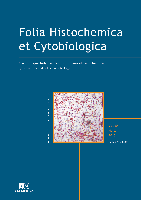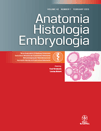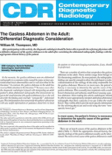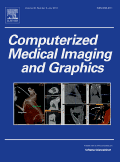
Journal of the Anatomical Society of India
Scope & Guideline
Unveiling the complexities of anatomy and pathology.
Introduction
Aims and Scopes
- Morphological and Morphometric Studies:
The journal emphasizes research on anatomical structures' morphology and morphometry, exploring variations across different populations and their clinical significance. - Clinical Relevance of Anatomical Findings:
It publishes studies that highlight the clinical implications of anatomical research, particularly how anatomical variations can affect surgical approaches and medical treatments. - Innovative Teaching Methods in Anatomy:
The journal explores and promotes innovative teaching methodologies in anatomy education, aiming to enhance the learning experience for medical students and professionals. - Integration of Advanced Technologies:
Research involving advanced imaging techniques (e.g., MRI, CT scans) and machine learning applications in anatomical studies is a key focus, reflecting the journal's commitment to integrating technology with anatomical research. - Pathological Anatomy:
The journal also covers studies related to pathological anatomy, investigating the anatomical changes associated with various diseases and conditions.
Trending and Emerging
- Application of Machine Learning in Anatomy:
Recent studies have increasingly employed machine learning algorithms to analyze anatomical data, showcasing a trend towards utilizing artificial intelligence in anatomical research and diagnostics. - Focus on Anatomical Variability and Its Clinical Implications:
There is a growing interest in studying anatomical variations and their clinical significance, particularly in surgical contexts, which is crucial for improving patient outcomes. - Neuroanatomy and Neurodevelopmental Studies:
Publications focusing on neuroanatomy, including studies related to neurodevelopmental disorders and brain morphology, are on the rise, highlighting the journal's engagement with contemporary neurological issues. - Research on Anatomical Education Innovations:
An increasing number of papers are addressing innovative teaching methods in anatomy, such as the use of 3D modeling and interactive learning, reflecting a shift towards enhancing educational practices in medical training. - Interdisciplinary Approaches:
Emerging studies that integrate anatomy with other disciplines, such as physiology, pathology, and technology, are becoming more prominent, reflecting a trend towards a more holistic understanding of human health.
Declining or Waning
- Traditional Cadaveric Studies:
While cadaveric studies have historically been a staple of anatomical research, there appears to be a waning emphasis on purely traditional cadaveric dissections, possibly due to the rise of advanced imaging techniques and ethical considerations. - Basic Anatomical Descriptions:
Research that focuses solely on basic anatomical descriptions without clinical relevance or innovative approaches seems to be less prevalent, as the journal shifts towards studies that emphasize clinical applications and implications. - General Anatomy without Technological Integration:
There is a noted decrease in publications that do not incorporate modern technologies or methodologies, reflecting a trend towards more sophisticated approaches in anatomical research.
Similar Journals

Brain Structure & Function
Illuminating Brain Complexity, One Study at a TimeBrain Structure & Function is a premier peer-reviewed journal published by Springer Heidelberg, focusing on the intricate relationships between brain anatomy and its functional implications. With a significant presence in the academic community, the journal is recognized for its high impact, evidenced by its rankings in the Q1 categories of Anatomy and Histology and its commendable position in the Neuroscience field. It has successfully maintained a convergence of research and innovation from 2007 to 2024, providing critical insights that drive forward our understanding of the brain. The journal's outstanding metrics, including a ranking of #6 in Anatomy and #18 in Histology within Scopus, highlight its role in shaping modern research. Offering open access options, Brain Structure & Function ensures that its cutting-edge findings and methodologies are accessible to a broad audience of researchers, professionals, and students eager to contribute to the evolution of neuroscience. With its comprehensive scope and commitment to high-quality research, this journal is an essential resource for anyone invested in the complexities of brain structure and their functions.

FOLIA MORPHOLOGICA
Bridging Knowledge Gaps in Anatomy and HistologyFOLIA MORPHOLOGICA is a prominent academic journal dedicated to advancing the fields of anatomy and histology. Published by VIA MEDICA since 1952, this journal serves as a critical platform for the dissemination of high-quality research, offering valuable insights into morphological studies. With an impact factor reflective of its dedication to rigorous scientific evaluation, FOLIA MORPHOLOGICA is recognized within the Q3 category in both anatomy and histology as of 2023, indicating its substantial contribution to these vital areas of medical science. Although currently not an open-access journal, it provides essential access options through various academic databases, ensuring that important findings are reachable by researchers, healthcare professionals, and students globally. The journal's scope encompasses a wide range of topics related to morphological sciences, making it a vital resource for those looking to stay at the forefront of anatomical and histological research. FOLIA MORPHOLOGICA remains dedicated to fostering scholarly communication and innovation, continuously aiming to enhance the scientific understanding of the intricate structures that underpin biological functions.

FOLIA HISTOCHEMICA ET CYTOBIOLOGICA
Advancing the Frontiers of Histology and CytobiologyFOLIA HISTOCHEMICA ET CYTOBIOLOGICA, an esteemed journal published by VIA MEDICA, serves as a vital platform for researchers and professionals in the fields of histology, pathology, and cytobiology. With an ISSN of 0239-8508 and E-ISSN of 1897-5631, this Open Access journal has been disseminating significant findings since 1984, offering free access to a broad audience of scientists and academics. Based in Poland, this journal focuses on critical advancements in the study of cellular structures and functions, contributing substantially to the understanding of various diseases and biological processes. The journal currently holds a respectable impact factor, ranking in the Q3 category for Histology and miscellaneous Medicine, and Q2 for Pathology and Forensic Medicine as per the 2023 metrics. With its commitment to quality research and an inclusive publishing approach, FOLIA HISTOCHEMICA ET CYTOBIOLOGICA is poised to continue influencing its fields significantly through 2024 and beyond.

ANATOMIA HISTOLOGIA EMBRYOLOGIA
Cultivating a Deeper Understanding of Biological SystemsANATOMIA HISTOLOGIA EMBRYOLOGIA, published by Wiley, is a well-regarded journal that serves as a vital resource in the field of anatomy and histology, with a particular emphasis on embryological studies. Established in 1972, this journal fosters cutting-edge research and discussions that deepen our understanding of the intricate relationships between structure and function across various species, while also addressing the parallels within veterinary and medical contexts. Though currently not open access, the journal maintains a significant impact within its scope, evidenced by its strong performance in Scopus rankings, particularly in the veterinary sciences, where it stands at rank #81 out of 194. With its dedicated focus on progressive scientific inquiry and publication regularly until 2024, the journal is committed to advancing knowledge and providing a platform for scholars, researchers, and practitioners alike. ANATOMIA HISTOLOGIA EMBRYOLOGIA is pivotal for those aiming to engage with the latest findings and methodologies in the fields of medicine and veterinary science, ensuring it remains an essential addition to any academic library.

Contemporary Diagnostic Radiology
Advancing the Frontiers of Medical ImagingContemporary Diagnostic Radiology is a pivotal journal in the field of medical imaging and radiology, published by Lippincott Williams & Wilkins. With an ISSN of 0149-9009 and an E-ISSN of 1938-1395, this journal serves as an essential platform for disseminating high-quality research and advances in diagnostic radiology and related disciplines. While it is categorized in the lower quartiles (Q4) for its performance in the 2023 rankings in both Neurology, Radiology, Nuclear Medicine and Imaging, and Surgery, its focus on emerging technologies and methodologies in imaging continues to provide valuable insights for practitioners and researchers alike. The journal’s scope includes innovative diagnostic tools, imaging techniques, and case studies, fostering collaboration and knowledge sharing in the medical community. Although it does not offer open access options, its commitment to contributing to the ongoing dialogue in clinical imaging is undisputed, making it an essential resource for professionals seeking to stay abreast of current trends and research in the rapidly evolving landscape of diagnostic radiology.

Medical Molecular Morphology
Exploring the Intersection of Histology and Therapy.Medical Molecular Morphology, published by SPRINGER JAPAN KK, stands as a significant resource in the fields of medicine and molecular biology, bridging critical insights between histological studies and modern therapeutic approaches. With an ISSN of 1860-1480 and E-ISSN of 1860-1499, this journal has evolved since its inception in 1996 and has continued to provide a platform for innovative research through 2024, establishing its relevance particularly in the realms of medical pathology and molecular morphology. Although categorized as Q3 in Medicine (miscellaneous) and Q4 in Molecular Biology per the 2023 quartiles, the journal's unique contributions cannot be understated, as evidenced by its Scopus rankings, which place it in the 52nd percentile for Pathology and 19th percentile for Molecular Biology. The journal’s mission focuses on disseminating valuable findings that enhance the understanding of cellular and molecular structures and their implications in health and disease. As access options are not currently open access, it remains essential for professionals and researchers to consider the journal's contributions as they pursue academic growth and impactful research in these dynamic fields.

NATURE CELL BIOLOGY
Unraveling the Mysteries of Life at the Cellular LevelNature Cell Biology, published by Nature Portfolio, is a premier journal in the field of Cell Biology, distinguished by its impactful contributions to understanding cellular mechanisms and processes. With an impressive impact factor that places it in the top tier (Q1) of its category, it ranks #9 out of 285 in Scopus's metrics, reflecting a 97th percentile in the fields of Biochemistry, Genetics, and Molecular Biology. The journal has been a vital resource since its inception in 1999 and continues to deliver high-quality, peer-reviewed research that advances the study of cellular structures and functions. Although it does not offer open access options, subscribers and institutional libraries can access this wealth of knowledge to keep abreast of the latest discoveries and methodologies in cell biology. Researchers, professionals, and students alike will find Nature Cell Biology to be an indispensable tool for fostering innovation and facilitating academic discourse in this dynamic field.

COMPUTERIZED MEDICAL IMAGING AND GRAPHICS
Transforming Healthcare through Visual TechnologyCOMPUTERIZED MEDICAL IMAGING AND GRAPHICS, published by PERGAMON-ELSEVIER SCIENCE LTD, is a leading international journal that has significantly contributed to the fields of medical imaging, graphics, and informatics since its establishment in 1988. With a remarkable reputation reflected in its Q1 quartile rankings across multiple categories—including Computer Graphics, Health Informatics, and Radiology—this journal maintains a prominent position in the academic community, evidenced by its Scopus rankings where it ranks in the top percentile across various disciplines. The journal aims to advance knowledge and innovation within the intersection of technology and healthcare, featuring high-quality research that addresses contemporary challenges in medical imaging and graphical methodologies. With no open access options currently available, this journal serves as a crucial resource for researchers, professionals, and students who are at the forefront of advancing imaging technology and its applications in medicine.

INTERNATIONAL JOURNAL OF MORPHOLOGY
Pioneering Discoveries in Organismal StructureThe INTERNATIONAL JOURNAL OF MORPHOLOGY is a distinguished publication dedicated to the field of anatomy, significantly contributing to the scholarly discourse within this essential area of medical science. Published by the SOC CHILENA ANATOMIA and located in Chile, this journal aims to disseminate groundbreaking research that explores the structural aspects of organisms, from comparative anatomy to developmental processes. With an H-index reflecting its growing impact, the journal has achieved a Q3 ranking in the category of Anatomy according to the 2023 metrics, positioning it among the competitive resources available to the scientific community. Researchers and professionals engaging with this journal can expect to encounter rigorous studies, insightful reviews, and innovative methodologies. Though not strictly open access, the journal remains pivotal for those keen on advancing their understanding of morphological structures and their implications in various fields. With convergence ongoing from 2006 to 2024, the INTERNATIONAL JOURNAL OF MORPHOLOGY is poised to further solidify its role as a vital source of knowledge for anatomy enthusiasts and experts alike.

ANATOMICAL SCIENCE INTERNATIONAL
Bridging Basic Anatomy and Clinical ApplicationsANATOMICAL SCIENCE INTERNATIONAL is a distinguished peer-reviewed journal published by SPRINGER, focusing on the field of anatomy and its applications within the broader spectrum of medical science. With an ISSN of 1447-6959 and an E-ISSN of 1447-073X, this journal provides a robust platform for the dissemination of innovative research and findings from around the globe, featuring studies that span from basic anatomy to advanced clinical applications. As of 2023, it holds a respectable Q2 rank in Anatomy and a Q3 rank in the miscellaneous category of Medicine, reflecting its growing influence and contribution to the field, with Scopus rankings placing it in the 59th percentile of Medicine - Anatomy journals. Although ANATOMICAL SCIENCE INTERNATIONAL is not an Open Access journal, it remains indispensable for researchers, professionals, and students who seek to stay at the forefront of anatomical science research. The journal's ongoing commitment to excellence is evident through its continuous publication, spanning from 2002 and projected through 2024, making it a vital resource for those aiming to advance their knowledge and practice in anatomy.